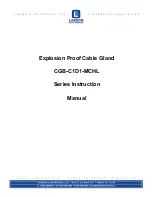
Larson Electronics, LLC
Phone:
877-348-9680
Fax: (903) 498-3364
www.larsonelectronics.com
3. Electrical tape MUST be wrapped around the tips of the cable cores.
This is to ensure the cable cores are together and also to cover any sharp
edges that could potentially tear the resin dam during installation.
4.
Pass the cable through the gland until the armor makes contact with the end stop. If it is not possible for the insulated con-
ductors to pass through the end stop then it should be removed so that the armor can make contact with the integral end stop
within the entry component. At this stage unscrew the outer nut and slide it back over the cable, enough to have access to the
armor spacer. If no access is gained repeat step 2 and trim the outer jacket up to the length plus 10%. Assemble the gland.
Hand tighten the outer nut to compress the
grounding spring to secure the armor. Do not over
tighten the outer nut. Remove electrical tape from
cable core tips. Separate the cable cores slightly to
allow resin to flow between them. When insulating
grounding conductors are present, spread the
strands slightly to allow the resin to form a full seal.
Refer to
sealing compound
instructions to fill the
gland resin tube with the required amount of
sealing compound
.
Note: For instrumentation cables utilizing shielded cable,
individual/overall drain wires, see Installation Guidance Notes
overleaf.
5. Once the resin has cured, loosen the outer nut to ensure that the grounding spring is not gripping the cable. Slide the outer nut back over
the cable, enough to loosen the armor spacer from the entry component. Screw the entry component into the enclosure. Retighten the armor
spacer when the entry component is fully tightened into the enclosure.
6. Finally, holding the cable central in the gland, tighten the Outer Nut to compress the Grounding Spring to secure the armor and
the seal to engage the cable jacket. Do not over tighten the Outer Nut. The Entry Component and Outer Nut do not have to
close face-to-face.
6
of
7
CGB-C1D1-MCHL
Series


























